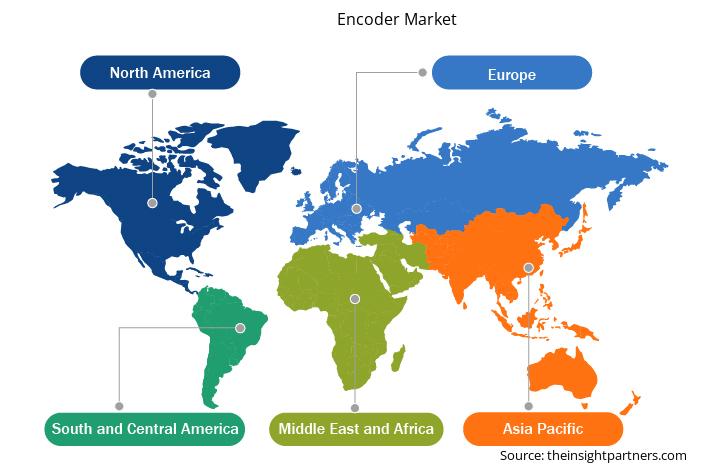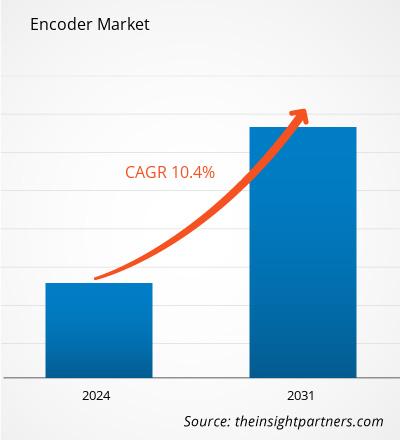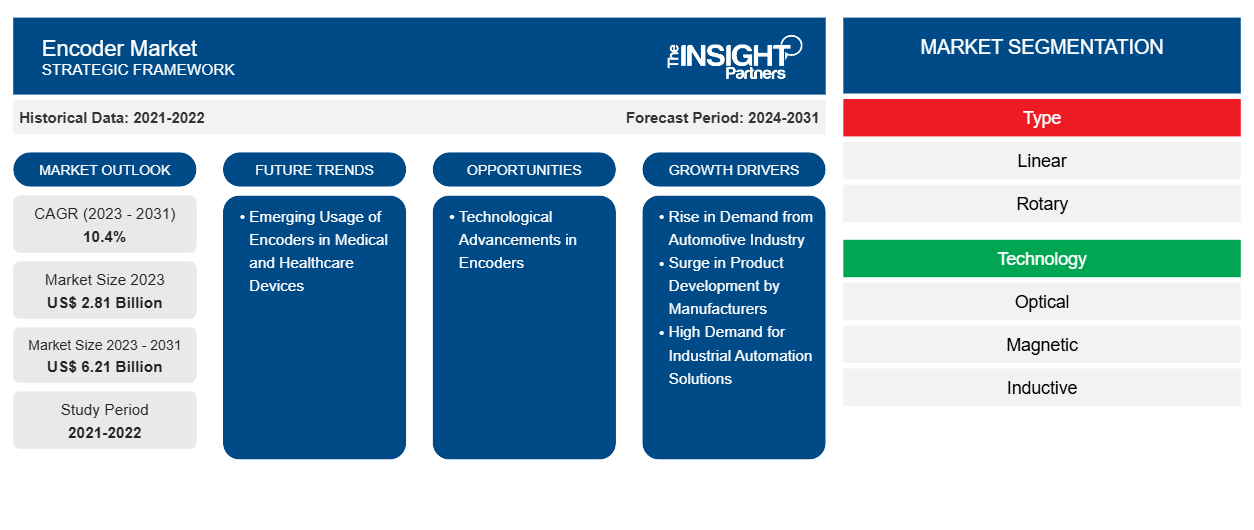La taille du marché des encodeurs devrait atteindre 6,21 milliards USD d'ici 2031, contre 2,81 milliards USD en 2023. Le marché devrait enregistrer un TCAC de 10,4 % au cours de la période 2023-2031. L'utilisation émergente des encodeurs dans les appareils médicaux et de santé est susceptible d'apporter de nouvelles tendances sur le marché dans les années à venir.
Analyse du marché des encodeurs
Français L'augmentation de la demande de l'industrie automobile, la forte demande de solutions d'automatisation industrielle parmi les petites, moyennes et grandes entreprises et l'accent mis par les fabricants sur la fabrication de nouvelles voitures sont quelques-uns des facteurs importants qui stimulent le marché des codeurs . En outre, l'augmentation des investissements dans la robotique et les solutions d'automatisation industrielle augmente la demande mondiale de codeurs. En outre, les progrès technologiques et l'intégration de technologies avancées telles que la technologie de l'Internet des objets industriel (IIoT), les codeurs à grande vitesse, les capteurs photo à réseau phasé HD et une puce LED bleue dans les codeurs qui réduisent les coûts d'exploitation devraient créer des opportunités de croissance du marché au cours de la période de prévision. De plus, l'augmentation de la demande de codeurs personnalisés, l'accent mis par les fabricants sur le développement de mini-codeurs et l'augmentation des activités de recherche et développement propulsent le marché des codeurs.
Aperçu du marché des encodeurs
Un codeur est un dispositif qui transforme le mouvement en un signal électrique qui peut être lu par un dispositif de contrôle de mouvement tel qu'un compteur ou un automate programmable. Il traduit les informations d'un format ou d'un code à un autre, généralement en transformant le mouvement physique ou la position en un signal numérique. Le codeur envoie un signal de rétroaction qui peut être utilisé pour calculer la position, la vitesse et la direction. Cette procédure est nécessaire pour maintenir l'uniformité, la vitesse et la compression dans diverses applications techniques. Les codeurs jouent un rôle essentiel dans la traduction des mouvements mécaniques en données électriques utilisables, ce qui est nécessaire pour un contrôle et une automatisation précis du système. Les codeurs sont des composants essentiels de la technologie moderne qui garantissent la précision et le contrôle dans une large gamme d'applications, notamment les machines industrielles et l'électronique grand public. Ce niveau de précision est essentiel pour les tâches nécessitant une grande précision, telles que les chaînes de montage et les robots chirurgicaux. Les codeurs sont utilisés dans les appareils électroniques grand public tels que les souris et les claviers pour traduire les actions de l'utilisateur en signaux numériques que les ordinateurs peuvent gérer, améliorant ainsi l'expérience et l'engagement de l'utilisateur.
Personnalisez ce rapport en fonction de vos besoins
Vous bénéficierez d'une personnalisation gratuite de n'importe quel rapport, y compris de certaines parties de ce rapport, d'une analyse au niveau des pays, d'un pack de données Excel, ainsi que d'offres et de remises exceptionnelles pour les start-ups et les universités.
- Obtenez les principales tendances clés du marché de ce rapport.Cet échantillon GRATUIT comprendra une analyse de données, allant des tendances du marché aux estimations et prévisions.
Facteurs moteurs et opportunités du marché des encodeurs
Hausse de la demande de l'industrie automobile
Les voitures sont de plus en plus équipées d'une gamme de technologies avancées et numériques pour rendre la conduite plus sûre et plus confortable pour les utilisateurs. Les codeurs jouent un rôle important dans l'industrie automobile, améliorant la précision, les performances et la sécurité de nombreux systèmes du véhicule. Dans les voitures modernes et électriques, les codeurs sont utilisés dans une variété d'applications, notamment les systèmes de direction assistée électrique (EPS), les systèmes de contrôle du moteur, les systèmes de freinage antiblocage (ABS), les systèmes de contrôle de traction, le contrôle de la position des phares et les systèmes de batterie, entre autres. Dans les systèmes EPS, les codeurs sont utilisés pour surveiller la position du volant en garantissant un contrôle et une réponse exacts. De même, dans les systèmes ABS et de contrôle de traction, les codeurs sont utilisés pour détecter et empêcher le glissement des roues, ce qui contribue à améliorer la stabilité du véhicule. Par exemple, selon le rapport annuel Global Electric Vehicle Outlook 2024 de l'Agence internationale de l'énergie (AIE), près de 14 millions de voitures électriques ont été vendues dans le monde en 2023, soit 3,5 millions de plus qu'en 2022, soit une augmentation de 35 % d'une année sur l'autre ; cela porte le nombre total de voitures sur les routes à 40 millions. Cette croissance du nombre de voitures montre que la part des voitures électriques sur le marché automobile global est passée de 14 % en 2022 à 18 % en 2023. L'augmentation des ventes de voitures électriques dans le monde entier stimule l'adoption d'encodeurs par les constructeurs automobiles pour le contrôle des moteurs des véhicules électriques et hybrides. Ces encodeurs fournissent un retour d'information exact sur la vitesse, la position et la direction du moteur, permettant une meilleure efficacité énergétique et des performances améliorées. La fiabilité et la précision du retour d'information fourni par les encodeurs sont essentielles pour les utilisateurs et les fabricants afin d'améliorer la maniabilité du véhicule, de respecter les réglementations de sécurité et d'améliorer la technologie de conduite autonome. En outre, les progrès de l'industrie automobile et le développement croissant de l'automatisation et de l'électrification font grimper la demande d'encodeurs de haute précision. Les encodeurs de haute précision sont utilisés dans les systèmes de conduite autonome tels que le régulateur de vitesse adaptatif, qui utilise la vitesse et la position des roues pour gérer l'accélération et le freinage. Par conséquent, la demande croissante de circuits intégrés d'encodeur de l'industrie automobile stimule le marché des encodeurs.
Progrès technologiques dans les codeurs
La demande croissante d'automatisation industrielle, d'efficacité énergétique et de solutions durables dans les industries accroît le besoin de codeurs technologiquement avancés dans le monde entier. L'intégration de technologies avancées telles que l'Internet des objets industriel (IIoT) et de produits avancés, notamment des codeurs à grande vitesse, des capteurs photo à réseau phasé HD et une puce LED bleue, avec des codeurs peut fournir des fonctionnalités de surveillance et de contrôle avancées, qui pourraient permettre la collecte et l'analyse de données en temps réel. Par exemple, MELEXIS a lancé MLX90382, un circuit intégré de codeur à grande vitesse pour les solutions d'automatisation industrielle, de robotique et de mobilité. MLX90382 est un circuit intégré de codeur magnétique absolu intégré à un capteur de position magnétique monolithique. Il combine un frontal magnétique à effet Hall, un convertisseur analogique-numérique, un traitement de signal numérique sur puce avec une latence nulle et plusieurs pilotes de sortie, ce qui rend l'appareil adapté aux applications à moteur électrique, telles que les bras robotisés, les machines à tisser industrielles et les machines d'emballage automatisées. La taille miniature du MLX90382, son immunité aux champs parasites et sa prise en charge de la détection sur axe et hors axe permettent une intégration fluide dans les micromoteurs. Ces codeurs sont conçus pour répondre aux besoins de l'industrie en matière de rétroaction à grande vitesse, essentielle pour corriger le fonctionnement et la sécurité des applications à moteur électrique.
Selon les données de Valin Corporation de décembre 2022, l'IIoT offre des avantages substantiels aux encodeurs en améliorant l'accessibilité des données, les performances et la fiabilité. L'IIoT offre une surveillance en temps réel et des diagnostics à distance, permettant aux travailleurs de suivre en permanence l'état et les performances de l'encodeur en éliminant les temps d'arrêt. Par exemple, l'encodeur Ethernet industriel Sendix de Kubler avec une interface OPC UA intégrée est parfaitement adapté aux applications IIoT. Il est capable d'automatiser la communication indépendante du contrôle avec une solution cloud ou un autre système de niveau supérieur. La configuration de l'encodeur via Internet permet une communication inter-systèmes et élimine les défauts rapidement et efficacement en cas de panne. Par exemple, les encodeurs Ethernet industriels Kubler intégrés aux interfaces Profinet, EtherCAT ou EtherNet/IP prennent en charge l'interface OPC UA, augmentant ainsi la polyvalence et permettant de transmettre simultanément les données au contrôle, au serveur Web ou au cloud. L'intégration d'encodeurs aux systèmes compatibles IIoT permet de collecter, de traiter et de stocker les données de ces appareils sur des plateformes basées sur le cloud, offrant ainsi des informations importantes sur les modèles d'équipement et l'efficacité opérationnelle.
Ainsi, les avancées technologiques dans les encodeurs devraient créer des opportunités de croissance pour le marché des encodeurs au cours de la période de prévision.
Analyse de segmentation du rapport sur le marché des encodeurs
Les segments clés qui ont contribué à l’élaboration de l’analyse du marché des encodeurs sont le type et la technologie.
- En fonction du type, le marché des codeurs est divisé en linéaire et rotatif. Le segment rotatif détenait une part de marché plus importante en 2023.
- En fonction de la technologie, le marché des codeurs est segmenté en optique, magnétique, inductif et autres. Le segment optique détenait la plus grande part du marché en 2023.
Analyse des parts de marché des encodeurs par géographie
La portée géographique du rapport sur le marché des codeurs est principalement divisée en cinq régions : Amérique du Nord, Asie-Pacifique, Europe, Moyen-Orient et Afrique, et Amérique du Sud et centrale.
L'Amérique du Nord détenait une part de marché importante en 2023. Les États-Unis, le Canada et le Mexique figurent parmi les principales économies d'Amérique du Nord. La région contribue de manière notable au marché mondial des codeurs en raison des investissements croissants des industries dans l'adoption de robots. Par exemple, selon les données de la Fédération internationale de robotique (IFR) publiées en avril 2024, les industries des États-Unis, du Canada et du Mexique investissent massivement dans l'adoption et l'installation de robots pour automatiser les processus industriels. L'automobile, l'électricité, l'électronique et la fabrication sont les principales industries qui investissent massivement dans les technologies robotiques, augmentant la demande de codeurs pour gérer la position, la vitesse et le mouvement des pièces robotisées.
Les États-Unis sont le deuxième producteur mondial de voitures et de véhicules légers après la Chine. Les ventes sur le marché automobile aux États-Unis ont augmenté de 1 %, avec un record de 14 678 robots installés en 2023, qui ont augmenté de 47 % avec 14 472 unités installées en 2022. En 2023, les fabricants d'automobiles et de composants représentent 33 % de tous les déploiements de robots industriels dans le pays. De même, en 2023, les installations de robots au Canada ont augmenté de 43 % pour atteindre 4 616 unités. Français L'industrie automobile représentait 55 % des installations de robots du pays, et les ventes du secteur automobile ont augmenté de 99 %, avec 2 549 unités installées en 2023. De plus, le nombre de robots installés dans l'industrie manufacturière mexicaine a atteint 5 868 unités dans l'industrie automobile en 2023. L'industrie automobile est le plus grand adoptant de robots du pays, représentant 69 % du total des installations dans lesquelles les ventes ont totalisé 4 068 unités en 2023. L'expansion croissante de l'industrie automobile et l'installation croissante de robots ont stimulé l'adoption d'encodeurs dans les lignes de production automobile. Les encodeurs sont utilisés dans les lignes de fabrication automobile pour maintenir une précision constante, réduire les erreurs et garantir des actions répétitives pour les robots. Les robots de l'industrie automobile sont responsables de tâches telles que l'installation de pièces, l'application de revêtements et les opérations de soudage complexes. Les encodeurs permettent aux robots de réagir en temps réel à toute différence de position en optimisant l'efficacité et la qualité des processus.
Aperçu régional du marché des encodeurs
Les tendances et facteurs régionaux influençant le marché des encodeurs tout au long de la période de prévision ont été expliqués en détail par les analystes d’Insight Partners. Cette section traite également des segments et de la géographie du marché des encodeurs en Amérique du Nord, en Europe, en Asie-Pacifique, au Moyen-Orient et en Afrique, ainsi qu’en Amérique du Sud et en Amérique centrale.

- Obtenez les données régionales spécifiques au marché des encodeurs
Portée du rapport sur le marché des encodeurs
| Attribut de rapport | Détails |
|---|---|
| Taille du marché en 2023 | 2,81 milliards de dollars américains |
| Taille du marché d'ici 2031 | 6,21 milliards de dollars américains |
| Taux de croissance annuel composé mondial (2023-2031) | 10,4% |
| Données historiques | 2021-2022 |
| Période de prévision | 2024-2031 |
| Segments couverts | Par type
|
| Régions et pays couverts | Amérique du Nord
|
| Leaders du marché et profils d'entreprises clés |
|
Densité des acteurs du marché des encodeurs : comprendre son impact sur la dynamique commerciale
Le marché des encodeurs connaît une croissance rapide, tirée par la demande croissante des utilisateurs finaux en raison de facteurs tels que l'évolution des préférences des consommateurs, les avancées technologiques et une plus grande sensibilisation aux avantages du produit. À mesure que la demande augmente, les entreprises élargissent leurs offres, innovent pour répondre aux besoins des consommateurs et capitalisent sur les tendances émergentes, ce qui alimente davantage la croissance du marché.
La densité des acteurs du marché fait référence à la répartition des entreprises ou des sociétés opérant sur un marché ou un secteur particulier. Elle indique le nombre de concurrents (acteurs du marché) présents sur un marché donné par rapport à sa taille ou à sa valeur marchande totale.
Les principales entreprises opérant sur le marché des codeurs sont :
- Micro-appareils Asahi Kasei Corp.
- Vishay Intertechnology Inc
- Société Malade AG
- Honeywell International Inc
- ROHM Co., Ltd.
- Allegro MicroSystems Inc
Avis de non-responsabilité : les sociétés répertoriées ci-dessus ne sont pas classées dans un ordre particulier.

- Obtenez un aperçu des principaux acteurs du marché des encodeurs
Actualités et développements récents du marché des encodeurs
Le marché des encodeurs est évalué en collectant des données qualitatives et quantitatives après des recherches primaires et secondaires, qui comprennent d'importantes publications d'entreprise, des données d'association et des bases de données. Quelques-uns des développements du marché des encodeurs sont répertoriés ci-dessous :
- OMRON Automation, un important fournisseur de solutions d'automatisation industrielle avancées en Inde, vise à renforcer sa stratégie commerciale centrée sur i-Belt, le service de solutions de co-création basé sur les données de l'entreprise. Connu pour son vaste portefeuille couvrant les capteurs intelligents, les robots, la vision, la sécurité des machines, les PLC, les servomoteurs et les variateurs, OMRON est prêt à enrichir davantage sa gamme de solutions de bout en bout en s'intégrant au service basé sur les données i-Belt. (Source : OMRON, communiqué de presse, août 2023)
- Microchip Technology Inc. a annoncé une initiative pluriannuelle de plus de 300 millions de dollars américains pour étendre sa présence en Inde. Grâce à cet investissement, la société vise à établir des centres de recherche sur les semi-conducteurs, de conception de puces et d'ingénierie d'équipements dans le pays. Le même mois, Microchip Technology Inc. a inauguré un centre de recherche et développement à Hyderabad. Selon la société, le marché des semi-conducteurs en Inde devrait atteindre 64 milliards de dollars américains d'ici 2026, contre 22,7 milliards de dollars américains en 2019. (Source : Microchip Technology Inc., communiqué de presse, juillet 2024)
Rapport sur le marché des encodeurs : couverture et livrables
Le rapport « Taille et prévisions du marché des codeurs (2021-2031) » fournit une analyse détaillée du marché couvrant les domaines ci-dessous :
- Taille et prévisions du marché des encodeurs aux niveaux mondial, régional et national pour tous les segments de marché clés couverts par le champ d'application
- Tendances du marché des encodeurs, ainsi que la dynamique du marché telle que les moteurs, les contraintes et les opportunités clés
- Analyse PEST et SWOT détaillée
- Analyse du marché des encodeurs couvrant les principales tendances du marché, le cadre mondial et régional, les principaux acteurs, les réglementations et les développements récents du marché
- Analyse du paysage industriel et de la concurrence couvrant la concentration du marché, l'analyse de la carte thermique, les principaux acteurs et les développements récents du marché des encodeurs
- Profils d'entreprise détaillés
- Analyse historique (2 ans), année de base, prévision (7 ans) avec TCAC
- Analyse PEST et SWOT
- Taille du marché Valeur / Volume - Mondial, Régional, Pays
- Industrie et paysage concurrentiel
- Ensemble de données Excel
Rapports récents
Témoignages
Raison d'acheter
- Prise de décision éclairée
- Compréhension de la dynamique du marché
- Analyse concurrentielle
- Connaissances clients
- Prévisions de marché
- Atténuation des risques
- Planification stratégique
- Justification des investissements
- Identification des marchés émergents
- Amélioration des stratégies marketing
- Amélioration de l'efficacité opérationnelle
- Alignement sur les tendances réglementaires























 Obtenez un échantillon gratuit pour - Marché des encodeurs
Obtenez un échantillon gratuit pour - Marché des encodeurs